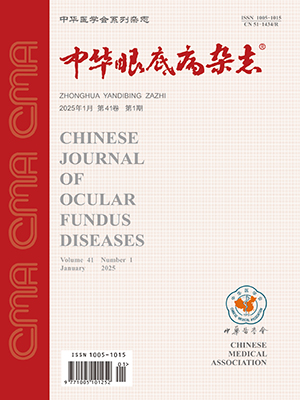| 1. |
Ahmed Jan N, Mui RK, Masood S. Waardenburg syndrome[M]. StatPearls[Internet]: Treasure Island (FL), 2021. https://www.ncbi.nlm.nih.gov/books/NBK560879/.
|
| 2. |
Newton V. Hearing loss and Waardenburg's syndrome: implications for genetic counselling[J]. J Laryngol Otol, 1990, 104(2): 97-103. DOI: 10.1017/s002221510011196x.
|
| 3. |
Pingault V, Ente D, Dastot-Le Moal F, et al. Review and update of mutations causing Waardenburg syndrome[J]. Hum Mutat, 2010, 31(4): 391-406. DOI: 10.1002/humu.21211.
|
| 4. |
Nicole LD, Chaya K. The neural crest[M]. 2nd ed. London: Cambridge University Press, 1999: 24-27.
|
| 5. |
Read AP, Newton VE. Waardenburg syndrome[J]. J Med Genet, 1997, 34(8): 656-665. DOI: 10.1136/jmg.34.8.656.
|
| 6. |
Bocángel MAP, Melo US, Alves LU, et al. Waardenburg syndrome: novel mutations in a large Brazilian sample[J]. Eur J Med Genet, 2018, 61(6): 348-354. DOI: 10.1016/j.ejmg.2018.01.012.
|
| 7. |
Liu Y, Pan H, Wang J, et al. Ophthalmological features and treatments in five cases of Waardenburg syndrome[J]. Exp Ther Med, 2020, 20(4): 3072-3077. DOI: 10.3892/etm.2020.9035.
|
| 8. |
Tang XJ, Ping XY, Luo CQ, et al. Dystrophia canthorum in Waardenburg syndrome with a novel MITF mutation[J]. Int J Ophthalmol, 2020, 13(7): 1054-1059. DOI: 10.18240/ijo.2020.07.06.
|
| 9. |
Vichare N, Bhargava N. Waardenburg syndrome: a rare case with bilateral congenital cataract: an unusual entity[J]. Med J Armed Forces India, 2013, 69(2): 172-174. DOI: 10.1016/j.mjafi.2012.02.017.
|
| 10. |
Cortés-González V, Zenteno JC, Guzmán-Sánchez M, et al. Tietz/Waardenburg type 2A syndrome associated with posterior microphthalmos in two unrelated patients with novel MITF gene mutations[J]. Am J Med Genet A, 2016, 170(12): 3294-3297. DOI: 10.1002/ajmg.a.37937.
|
| 11. |
Shields CL, Nickerson SJ, Al-Dahmash S, et al. Waardenburg syndrome: iris and choroidal hypopigmentation[J]. JAMA Ophthalmol, 2013, 131(9): 1167-1173. DOI: 10.1001/jamaophthalmol.2013.4190.
|
| 12. |
Mullaney PB, Parsons MA, Weatherhead RG, et al. Clinical and morphological features of Waardenburg syndrome type Ⅱ[J]. Eye (Lond), 1998, 12 (Pt 3a): 353-357. DOI: 10.1038/eye.1998.85.
|
| 13. |
Planque N, Raposo G, Leconte L, et al. Microphthalmia transcription factor induces both retinal pigmented epithelium and neural crest melanocytes from neuroretina cells[J]. J Biol Chem, 2004, 279(40): 41911-41917. DOI: 10.1074/jbc.M404964200.
|
| 14. |
Müllner-Eidenböck A, Moser E, Frisch H, et al. Waardenburg syndrome type 2 in a Turkish family: implications for the importance of the pattern of fundus pigmentation[J]. Br J Ophthalmol, 2001, 85(11): 1384-1386. DOI: 10.1136/bjo.85.11.1384.
|
| 15. |
Forrester JV, Dick AD, McMenamin PG, et al. The eye basic sciences in practice[M]. 4th ed. New York: Elsevier (Singapore) Pte Ltd. , 2016: 80-83.
|
| 16. |
El-Chemaly S, Young LR. Hermansky-pudlak syndrome[J]. Clin Chest Med, 2016, 37(3): 505-511. DOI: 10.1016/j.ccm.2016.04.012.
|
| 17. |
Jelena B, Christina L, Eric V, et al. Phenotypic variability in Waardenburg syndrome resulting from a 22q12.3-q13.1 microdeletion involving SOX10[J]. Am J Med Genet A, 2014, 164A(6): 1512-1519. DOI: 10.1002/ajmg.a.36446.
|
| 18. |
顾虹. Waardenburg综合征一家系二例[J]. 中华眼底病杂志, 2020, 36(12): 971-972. DOI: 10.3760/cma.j.cn511434-20191018-00335.Gu H. Two cases of Waardenburg syndrome in one family[J]. Chin J Ocul Fundus Dis, 2020, 36(12): 971-972. DOI: 10.3760/cma.j.cn511434-20191018-00335.
|
| 19. |
Bansal Y, Jain P, Goyal G, et al. Waardenburg syndrome-a case report[J]. Cont Lens Anterior Eye, 2013, 36(1): 49-51. DOI: 10.1016/j.clae.2012.10.083.
|
| 20. |
Wang HH, Chen HS, Li HB, et al. Identification and functional analysis of a novel mutation in the SOX10 gene associated with Waardenburg syndrome type Ⅳ[J]. Gene, 2014, 538(1): 36-41. DOI: 10.1016/j.gene.2014.01.026.
|
| 21. |
Touraine RL, Attié-Bitach T, Manceau E, et al. Neurological phenotype in Waardenburg syndrome type 4 correlates with novel SOX10 truncating mutations and expression in developing brain[J]. Am J Hum Genet, 2000, 66(5): 1496-1503. DOI: 10.1086/302895.
|
| 22. |
赵娜, 王晶, 肖涵, 等. 中国人群Waardenburg综合征的临床及基因变异特点分析[J]. 中华医学遗传学杂志, 2020, 37(10): 1186-1190. DOI: 10.3760/cma.j.cn511374-20190610-00288.Zhao N, Wang J, Xiao H, et al. Clinical and genetic characteristics of Chinese patients with Waardenburg syndrome[J]. Chin J Med Genet, 2020, 37(10): 1186-1190. DOI: 10.3760/cma.j.cn511374-20190610-00288.
|




